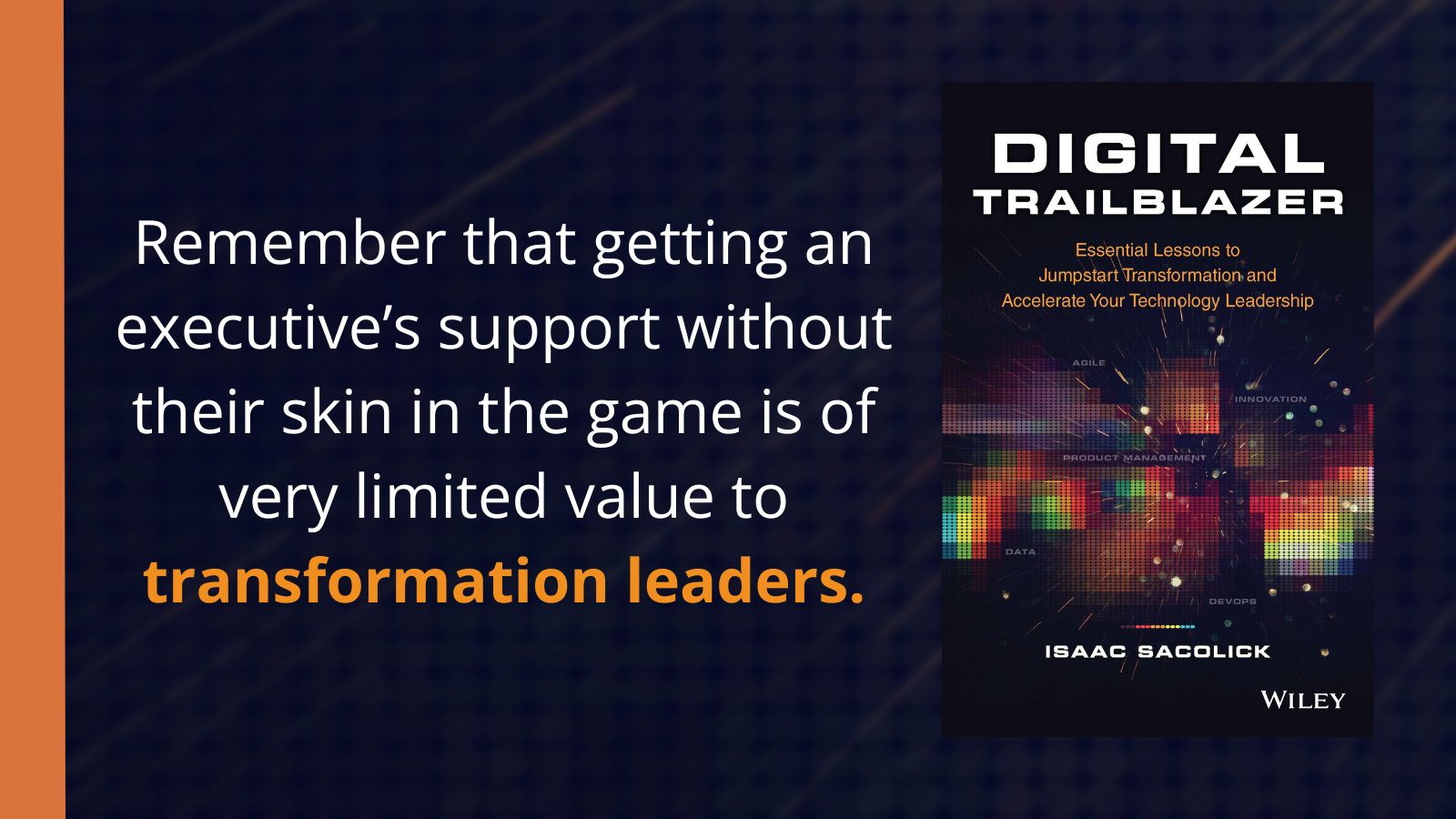“Managing up is a career development method that involves working with your boss to create value for both of you.” This is how Google’s AI explains managing up, a set of career management practices for developing relationships with your manager and other higher-level executives.
I confess – I sucked at managing up during my days as CTO and CIO. From my
naïve lens, I equated managing up to ass kissing, allowing my introversion
to mask and underinvest in this critical career management practice. I
believed that demonstrating strong communication, delivering continuous
results, and fostering a culture of innovation and transformation were all I
needed to promote my career aspirations.
Even when I was a CIO with a seat at the table, I wasn’t always a member of the CEO’s inner circle of trusted advisors. I may have been the the last to learn about critical developments and was passed over for several growth opportunities.
.png)
Digital Trailblazers
who don’t excel at managing up may find it difficult to get the support
needed to
drive transformation and change management. Leadership may assign you a tier-2 cost optimization initiative instead
of the most strategic growth-driven opportunities. Executives may recognize
you as a GSD leader – someone who gets shit done – and not a strategic
thinker, vision painter, or value driver – three key
Digital Trailblazer competencies.
At a recent
Coffee with Digital Trailblazers, we discussed the importance of developing relations with business
executives. We have a session coming up on April 12 around
developing relationships with board members.
Treat managing up as a collaboration and partnership
For this post, I concentrate on managing up to your manager, your manager’s
manager, and C-level executives. My goal was to find easy approaches that
fit into a Digital Trailblazer’s objectives and require fewer social
behaviors that can be challenging for introverts.
I reviewed several good articles on managing up, selected ten
recommendations, and added my interpretations.
The first two come from the
Guide to managing up: what it means and why it’s important.
1. Learn and adapt to your manager’s communication style and way of working
Every CEO I worked for had different communication needs. Some wanted
regular updates and program status details. Others only wanted to be
informed only when there were material business issues.
But keeping your direct manager updated and in the know isn’t a sufficient
managing up practice. Here are some easy recommendations:
- Learn their interests and motivations, including those outside of the office, and use this information to build a connection.
- Figure out optimal times to reach out with something new and interesting. Are they more likely to read your email early in the morning, on Friday afternoons, or another time during the week?
- Identify which meetings to invite them to, not because they have to be there, but because they will be interested in participating.
These basic relationship-building skills may take some trial and learning until you make a connection.
2. Proactively reach out to your manager when you need help
I love this recommendation because any leader who’s worth managing up to
should respond when there’s a direct request for help. Think of asking for
advice on a cadence, maybe once a quarter. Do your homework and have options
or solutions in mind, then ask your manager for their perspectives. In
addition to getting advice, your manager gains a sense of importance and
accomplishment when being solicited for their knowledge and expertise.
These next two recommendations come from
how to manage up at work.
3. Offer solutions, not problems

Read my story in Chapter 4 of
Digital Trailblazer when the
CEO asks me how I plan to address problems in a major strategic program I
inherited. I think to myself, “Fuck. I know better than to show up at the
CEO’s office with a problem but without a plan or a solution.”
Leaders and managers have their own issues and stresses. Show up with
problems, and you’re adding to their to-do list, or worse, creating a
perception that you can’t plan or execute when facing obstacles. Have
options and tradeoffs, or come up with steps and a timeline to develop
solutions.
4. Ask questions and understand their expectations
When leading a digital transformation initiative, you have to separate your
manager’s opinions as a stakeholder versus where they have decision-making
authority. Drafting a
vision statement
is a vital tool to begin this process, and soliciting your manager’s
feedback on what success looks like is a key question to ask at the start of
a program.

Managing up means you must repeat your questions in different ways and at
different times. Requirements, priorities, and expectations evolve. Don’t
just report on status – find an approach and cadence to discuss, ask
questions, and evolve strategies.
From:
Learn These 5 Tactics To Manage Up And Propel Your Leadership Career
5. Be proactive about your performance review
Leaders and managers have short-term memories, and your accomplishments in
March will be long forgotten when performance reviews are done later in the
year. Digital Trailblazers must market their teams’ accomplishments
regularly.
Look beyond your direct manager as the audience. All stakeholders must
recognize not only what your teams delivered but also what you accomplished
as their leader.
Of the
15 principles for managing up,
these two really stand out for Digital Trailblazer.
6. Focus on the punchline
Think of storytelling in reverse, formulate the conclusion, and consider why
your manager and leaders should care. Of all the issues, updates, and
decisions you share with leaders, why this one or two? Avoid trying to
squeeze in three.
Your direct manager is busy. Form a punchline around the conclusion that will garner interest. Turn on your active listening skills, including non-verbal indicators, as to whether your manager wants the short or very short version of your storyline.
7. Be explicit about what you need
In Digital Trailblazer, I stress the importance of getting more than stakeholder support,
including your direct manager and other leaders up the hierarchy. “Remember
that getting an executive’s support without their skin in the game is of
very limited value to transformation leaders.”

Come with a firm ask and clarify what support you need. Do you need a budget
approved faster? Do you need help with a
vocal detractor
above your pay grade? Do you want your direct manager’s attendance at a
brainstorming session?
Your CEO Mentor
shared several recommendations on managing up – here’s a key one:
8. Feed your boss insights and observations they can’t access themselves
This recommendation is particularly important when presenting data and
dashboards. Share the data first so that your manager understands the facts
and assumptions. Then, share your insights – what does the data suggest?
You’ve reviewed and analyzed the data longer than your managers can with
limited time and patience.
But add observations about customers, operations, and other details
demonstrating understanding beyond the aggregate numbers. Help answer the
why with examples.
Of these
14 Tips To Manage Up at Work (And Why It’s Important), these two stand out.
9. Balance speaking about work tasks and personal life
This may be a challenging recommendation for Digital Trailblazers who
struggle to hold an unscripted conversation or share personal details. But,
aspiring leaders must find ways to
break out of their comfort zones
to be recognized for their leadership skills and rewarded with more
challenging opportunities.
It’s unlikely that your managers are all analytical introverts, and many will gauge your leadership acumen at least partially based on personal interactions. Identify some safe areas of your personal life you are willing to share, and think through where you might reveal these details in a work-related conversation.
10. Be honest when they ask for your feedback
When someone higher in the leadership hierarchy asks you for feedback,
recognize that you’ve succeeded in a managing up milestone. You’ve developed
trust, and the leader respects your opinion.
Pick one area, be specific with your feedback, and share why it’s important.
Be clear about the impacts and why you are providing feedback in the
selected area. Sharing feedback doesn’t require providing recommendations,
solutions, or answers; if asked, be ready to provide some constructive
ideas.

Like all
career development activities, I recommend developing a plan and tracking the impact of your efforts. If
you feel your career is stagnant, chances are you haven’t invested enough
energy in managing up.
Join us for a future session of Coffee with Digital Trailblazers, where we discuss topics for aspiring transformation leaders. If you enjoy my thought leadership, please sign up for the Driving Digital Newsletter and read all about my transformation stories in Digital Trailblazer.
 Digital Trailblazers! Join us Fridays at 11am ET for a live audio discussion on digital
transformation topics: innovation, product management, agile, DevOps,
data governance, and more!
Digital Trailblazers! Join us Fridays at 11am ET for a live audio discussion on digital
transformation topics: innovation, product management, agile, DevOps,
data governance, and more!


No comments:
Post a Comment
Comments on this blog are moderated and we do not accept comments that have links to other websites.